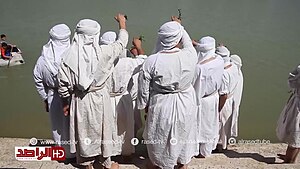Klila

In Mandaeism, the klila (Classical Mandaic: ࡊࡋࡉࡋࡀ) is a small myrtle (Classical Mandaic: ࡀࡎࡀ, romanized: asa) wreath or ring (translated as "circlet" by E. S. Drower[1]) used during Mandaean religious rituals. The klila is a female symbol that complements the taga, a white crown which always takes on masculine symbolism.[2][3]
The klila is used to adorn the drabsha, a wooden cross covered with a white cloth that is the main symbol of Mandaeism.[2]
Use in rituals
The klila is used during most Mandaean rituals, including masbuta, masiqta, and priest initiation rituals.[2]
In the Qolasta
Several prayers in the Qolasta are recited when consecrating and putting on the klila, including prayers 19, 46, 47, 61, and 79.[1]
In E. S. Drower's version of the Qolasta, prayers 305-329 are recited for the klila, as well as for the taga.[1]
Hazazban (or Haza-Zban) is mentioned in Qolasta prayers 19 and 27 as an uthra who sets wreaths (klila) upon the heads of Mandaeans who are performing masbuta.[1]
Syriac parallels
In the Syriac Peshitta, the word klila (Classical Syriac: ܟܠܝܠܐ, lit. 'wreath') is used to refer to Jesus' crown of thorns in the Gospels. In contrast, tga (Classical Syriac: ܬܓܐ, lit. 'diadem'), cognate with Mandaic taga, is used to refer to heavenly crowns in the Book of Revelation.[4]
See also
References
- ^ a b c d Drower, E. S. (1959). The Canonical Prayerbook of the Mandaeans. Leiden: E. J. Brill.
- ^ a b c Buckley, Jorunn Jacobsen (2002). The Mandaeans: ancient texts and modern people. New York: Oxford University Press. ISBN 0-19-515385-5. OCLC 65198443.
- ^ Drower, Ethel Stefana (1937). The Mandaeans of Iraq and Iran. Oxford at the Clarendon Press.
- ^ "Dukhrana Analytical Lexicon of the Syriac New Testament". Dukhrana Biblical Research. 2021-02-13. Retrieved 2023-12-10.
External links
- Preparing the klila: cutting myrtle (video)
- Sydney 2014 Masbuta 06: Crown the Baptisee with the Klila (photo gallery)














